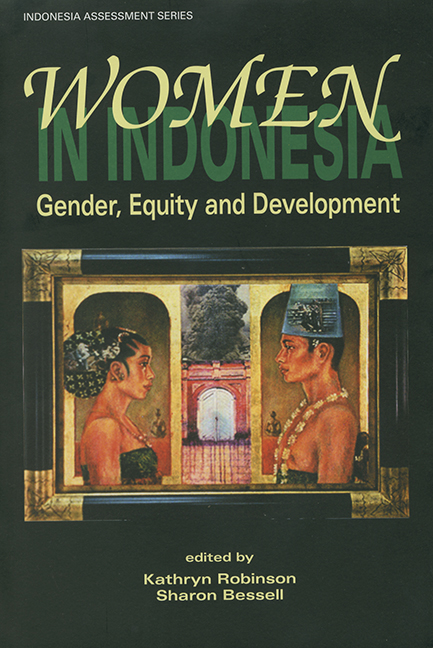Book contents
- Frontmatter
- Contents
- Tables
- Figures
- Contributors
- Acknowledgments
- Glossary
- Prologue
- 1 Introduction to the Issues
- 2 The Mega Factor in Indonesian Politics: A New President or a New Kind of Presidency?
- 3 The Downfall of President Abdurrahman Wahid: A Return to Authoritarianism?
- 4 The Year in Review: From Blind Man's Bluff to Mega Expectations
- 5 Further Comments on the Economy, with a Gender Perspective
- 6 Institution Building: An Effort to Improve Indonesian Women's Role and Status
- Commentary
- 7 Feminism in Indonesia in an International Context
- 8 Gay and Lesbi Subjectivities, National Belonging and the New Indonesia
- 9 And the Winner Is … Indonesian Women in Public Life
- 10 Indonesian Women Artists: Transcending Compliance
- 11 Literature, Mythology and Regime Change: Some Observations on Recent Indonesian Women's Writing
- 12 Women and the Labour Market during and after the Crisis
- 13 Women's International Labour Migration
- 14 Customary Institutions, Syariah Law and the Marginalisation of Indonesian Women
- 15 Women's Grassroots Movements in Indonesia: A Case Study of the PKK and Islamic Women's Organisations
- 16 Women's Activism against Violence in South Sulawesi
- 17 Gender Mainstreaming and Sex-disaggregated Data
- 18 The Changing Indonesian Household
- 19 Women, Family Planning and Decentralisation: New Variations on Old Themes
- 20 Men, Women and Community Development in East Nusa Tenggara
- References
- Index
- INDONESIA ASSESSMENT SERIES
18 - The Changing Indonesian Household
Published online by Cambridge University Press: 21 October 2015
- Frontmatter
- Contents
- Tables
- Figures
- Contributors
- Acknowledgments
- Glossary
- Prologue
- 1 Introduction to the Issues
- 2 The Mega Factor in Indonesian Politics: A New President or a New Kind of Presidency?
- 3 The Downfall of President Abdurrahman Wahid: A Return to Authoritarianism?
- 4 The Year in Review: From Blind Man's Bluff to Mega Expectations
- 5 Further Comments on the Economy, with a Gender Perspective
- 6 Institution Building: An Effort to Improve Indonesian Women's Role and Status
- Commentary
- 7 Feminism in Indonesia in an International Context
- 8 Gay and Lesbi Subjectivities, National Belonging and the New Indonesia
- 9 And the Winner Is … Indonesian Women in Public Life
- 10 Indonesian Women Artists: Transcending Compliance
- 11 Literature, Mythology and Regime Change: Some Observations on Recent Indonesian Women's Writing
- 12 Women and the Labour Market during and after the Crisis
- 13 Women's International Labour Migration
- 14 Customary Institutions, Syariah Law and the Marginalisation of Indonesian Women
- 15 Women's Grassroots Movements in Indonesia: A Case Study of the PKK and Islamic Women's Organisations
- 16 Women's Activism against Violence in South Sulawesi
- 17 Gender Mainstreaming and Sex-disaggregated Data
- 18 The Changing Indonesian Household
- 19 Women, Family Planning and Decentralisation: New Variations on Old Themes
- 20 Men, Women and Community Development in East Nusa Tenggara
- References
- Index
- INDONESIA ASSESSMENT SERIES
Summary
The household is the key locus of gender relations in Indonesia. It is formed through marriage, and the way marriages are arranged and the ages at which women and men marry reflect gender relationships. In turn, the dynamics of spousal and parent–child relationships within the household reflect norms of gender relationships and their adaptation to the particular circumstances individual families experience.
This chapter will summarise some of the changes that can be observed in the Indonesian family, and particularly the situation of women within the family. It will briefly examine the evidence on female-headed households, trends in the disruption of families due to widowhood or divorce, and the issue of household composition – who is actually living in the household, and who is away. The chapter then focuses specifically on the changing living patterns of young women – their education, age at marriage and labour force participation – and how these are affecting their relationships and living patterns. Finally, the chapter turns to the relationships between parents and adolescent children.
It is hard to get a statistical fix on how household dynamics are changing in Indonesia as a whole, let alone in different parts of the country. Moreover, regional differences would require a monograph rather than a chapter. Therefore, this chapter does not attempt to differentiate between regions, apart from making broad rural–urban comparisons.
SMALLER HOUSEHOLDS
The size of Indonesian households is gradually declining, as shown in Table 18.1. The figures given in the table are the net outcome of a number of causal factors, some operating to reduce household size and others to increase it. Factors operating to reduce family size are the decline in fertility over this period, as well as changing conventions about young people sharing accommodation in group housing with peers, or living alone. Factors operating to increase family size include delayed marriage (and the norm for young people to live at home until married), and increased longevity, resulting in longer periods during which the elderly live with their children in a joint household. The most influential factor is undoubtedly the decline in fertility, but the importance of offsetting factors is evident in the rather modest decline in average household size in the face of a very sharp decline in fertility.
- Type
- Chapter
- Information
- Women in IndonesiaGender, Equity and Development, pp. 219 - 234Publisher: ISEAS–Yusof Ishak InstitutePrint publication year: 2002

